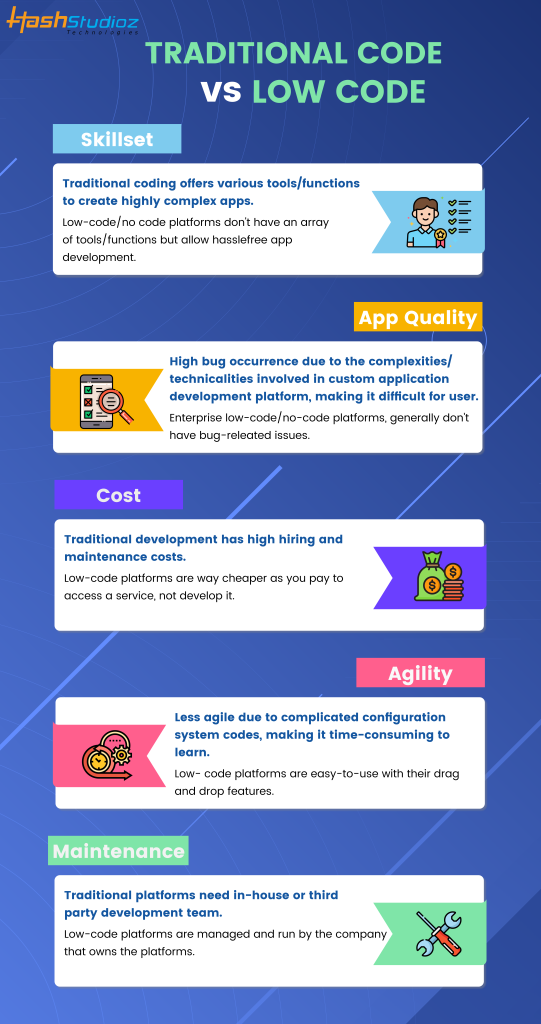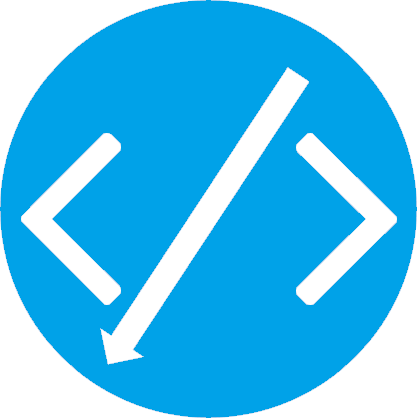Due to a number of factors, Low-code Application Development is accessible to non developers. These are known as "citizen designers."
Drag-and-Drop Builders: Low-code platforms have drag-and drop interfaces, which allow non-developers develop applications without needing to write any code. This makes it simpler for people who don't have technical expertise to be involved in the process of development.
WYSIWYG editors Editors that use WYSIWYG: These "What You See Is What You get" editors allow users to build interfaces and workflows that look like the finished product. This makes it easier to use and understand.
Simple Logic and Workflow
Visual Workflow Modeling: Users can design business processes and application logic through visual flowcharts and models, which are more intuitive than conventional coding techniques.
Low-code platforms usually come with pre-built logic elements (e.g. the conditional statements, loops) which eliminate the need for complicated programming.
Reusable Components and Templates:
Library of Templates Pre-built: Many platforms that offer low-code come with templates available for the most common applications. This allows developers to get started quickly and easily, while non-developers can customize the templates to their own preferences. appropriate.
Reusable modules and widgets by using reusable widgets or modules, the user can simplify the creation process, by eliminating the need for extensive technical know-how.
Guided development and tutorials:
Step-by-Step guides: Platforms provide tutorials and online assistance to non-developers who are building applications.
Interactive Tutorials: Interactive and hands-on tutorials enable users to learn by doing. They build confidence using the platform.
Integration with Tools Already in Use
Seamless Integration - Low-code systems can be easily integrated with existing systems and tools for business (e.g. ERP, CRM), allowing even non-developers the ability to build apps that are compatible to their workflows.
APIs/Connectors: The built-in APIs/connectors enable non-developers to connect their apps to external services.
Collaboration Features:
Team Collaboration real-time collaboration, shared workspaces, and shared workspaces allow business analysts, non-developers, and other stakeholder groups to effectively work with professional developers.
Role-Based Access Control: Those who are not developers are assigned roles that have adequate access levels to ensure that they can participate in the process of development without having to compromise security or functionality.
Automated testing and debugging:
Low-code platforms include tools for testing and debugging that are built in. They automatize this procedure, making it much simpler for non-developers to make sure their apps function.
Platform highlights errors when they happen and suggests solutions. This aids non-developers with troubleshooting.
Overall, the benefit of low-code application development in terms of accessibility for non-developers is in its ability to make the development process more accessible. Low-code platform platforms empower business users by providing them with an intuitive, visually and logical tools. They are then able to actively take part in the process of developing and maintaining the applications. See the recommended Low-code Platform for application development tips for blog tips including application modernization, rapid applications, cloud software applications, mobile app development platforms, application modernisation, azure sql server, multiplatform mobile app development, low code platforms, mobile app development platforms, rapid applications and more.

Benefits Of Low-Code Application Development With Respect To Governance And Security
Low-code app development provides several benefits for security and governance. This is vital to ensure that applications comply with the regulations, are secure and well-managed throughout their lifetime. These are the main benefits.
Unified Management Console : Low-code platforms provide a central management console to allow administrators to manage and oversee the entire application. This ensures consistent governance across the entire organization.
Role-Based Access Control RBAC : These platforms typically include access controls that are based on roles. They enable administrators to create and enforce rules. Only authorized users are able to change or access specific parts of a program.
Compliance and Regulatory Adherence
A lot of low-code platforms come with built-in conformity features. They're designed to comply with industry standards and regulations like GDPR or HIPAA. They provide frameworks and tools that help to ensure applications meet these requirements.
Audit Trails and Logging Complete audit trails and logging are typically integrated, allowing companies to track changes, monitor access, and make sure that they are in compliance with internal and external regulations.
Additional Security Measures
Data encryption: Low-code platforms commonly offer built-in encryption for data at rest and while in transit, making sure that data with sensitive information is secure.
Security Certifications Many low-code vendors have security certifications (e.g. ISO 27001, SOC 2 ) that demonstrate compliance with high security standards. This gives additional security to users.
Automated updates to ensure security:
Regular patches and updates: Low-code platforms handle most security patches and updates automatically. They ensure that apps are protected from the latest attacks without requiring developers to intervene manually.
Security Monitoring: Tools for constant security monitoring are available. They provide immediate alerts and insights into possible security issues.
Data Governance
Data Access Policies: These software tools permit companies to establish the data access policies, enforce them and keep track of policies. This ensures that information is only available to authorized users and used correctly.
Data Masking and Anonymization: Built-in tools for data masking and anonymization help protect sensitive data, particularly when working in testing and development environments.
Consistent Management of the lifecycle of an application
Development and deployment pipelines: Low-code platforms provide integrated development, including security tests. This guarantees security throughout the entire lifecycle of the application.
Version Control: An integrated version control system is used to manage changes, allowing any modifications that are made to an application to be tracked. If needed they can be reversed and the integrity of the application ensured.
User authentication:
Single Sign-On Support for single sign-on (SSO) as well as other advanced authentication mechanisms simplify management and enhances security.
Multi-Factor Authentication : Many platforms include built-in multi-factor authentication, providing a layer of extra security for accessing applications.
Policy Enforcement and Compliance Monitoring:
Low-code platform often comes with pre-defined policies templates that allow organizations to establish governance and cybersecurity policies quickly.
Compliance Monitoring Tools: These provide continuous monitoring and report on the status of compliance. This makes it easier to spot potential problems and address them proactively.
Integration with Existing Security Infrastructure
Seamless Integration: Platforms using low-code are designed to seamlessly integrate with the existing tools and infrastructure like SIEM (Security Information and Event Management solutions) and firewalls.
API Security: Integrated API security makes sure that integrations with an external systems are secure. Secure data and ensure the consistency of your application.
Best Practices and Training
Guided Best Practices: A number of platforms offer guidelines and best practices for developing secure applications, helping non-developers adhere to security standards.
Security Training: Certain low-code providers provide security training and resources that help users understand how to create and maintain secure applications.
Overall, the governance and security advantages assure that applications are built and managed securely and in accordance with regulations and in control. These platforms have the necessary frameworks and tools to safeguard sensitive data as well as enforce policies and ensure regulatory compliance, while facilitating management and oversight. Take a look at the top Enterprise application development with Low-code Platform examples for site advice including software for app development, rad application development, rad development, microsoft azure sql, app modernisation, build with docker, azure sql, jdbc server, cross platform mobile app development, stored sql procedures and more.

Low-Code Applications Offer Benefits In Terms Of Collaboration And Workflow
It's an excellent choice for businesses that want to improve team efficiency by streamlining processes and improving collaboration. Here are some of the benefits that are most notable: Improved cross-functional collaboration:
Unified Development Environment: Low-code platforms offer a unified, single environment in which all team members comprising business analysts, developers, designers, and other stakeholders are able to collaborate efficiently. This helps eliminate barriers.
Visual Development: The low-code platform's visual drag-anddrop capabilities make it easy for non-technical team members to contribute to the design process. It also ensures that business needs are properly documented and implemented.
Communication Enhanced
Real-Time Collaboration Features: Many platforms that use low-code offer real-time collaboration features, such as comments, editing, and instant feedback. These tools facilitate the communication process and decrease time spent discussing back and forth.
Shared workspaces: Teams have the ability to collaborate on shared workspaces where they can edit and discuss the project's elements. This will ensure that everyone is working towards the same goals and are on the same page.
A streamlined workflow management system:
Integrated Project Management Tools: A lot of low-code software platforms include integrated tools for project management that can help teams track and plan their projects for development. This includes the management of tasks, tracking progress and deadline management.
Workflow automation: Automating routine workflows and activities decreases the chance of errors and manual work, allowing teams and individuals to focus on more strategic projects and increase efficiency.
Faster Iteration:
Rapid Prototyping: Low-code platforms enable rapid prototyping and iterative design that allow teams to design prototypes, test, and refine applications in shorter cycles. This ensures feedback can be quickly integrated and improvements made.
Agile Development Support : Support of agile practices allows team members to be involved in sprints. They are able to continuously provide tiny increments of functionality and adapt more easily to changes in requirements.
Accessibility for non-developers
Citizen-driven development platforms allow business users to create and modify applications without requiring a lot of programming knowledge. This alleviates the burden of IT and development teams, and can provide faster responses to business requirements.
Training and onboarding. Intuitive tools and extensive training materials can help a new team members get acquainted and increase the overall level of collaboration.
Centralized Documentation and Knowledge Sharing:
Integrated Documentation: Low-code platforms include many features which allow the creation and maintaining of documentation within the platform. This ensures that all information related to the project is easily accessible and located centrally.
Knowledge Repositories. Teams can build and manage knowledge repositories, which contain best practices templates as well as a reuseable components, making it easier for knowledge exchange and reducing duplicate efforts.
Consistency in Standardization:
Standardized components: Standardized components that are pre-built ensure the consistency of applications. Team members can understand and work more easily on different parts.
Compliance and governance Frameworks built-in for governance ensure that all applications are created in line with organizational standards, regulatory requirements and standards for quality. They lower the risk of not being compliant and ensure that the application meets specifications.
Feedback and Improvement Loops
Integrated Feedback Systems: Low code platforms have integrated feedback systems that allow users to give feedback about the application. The feedback can then be used in the development of those applications.
Continuous Improvements: The ability for software to rapidly iterate and implement changes based off of feedback, ensuring that they are closely aligned to the needs of the user and business objectives.
Visualization and Reporting
Real-Time Analyses: The built-in reporting and analytics tools give immediate insight into project's progress, performance and user interactions, which allows for data-driven decisions.
Visual Workflow Mapping Visual tools that visualize workflows and processes can assist teams in optimizing their workflow by identifying bottlenecks.
In terms of collaboration, low-code software is a great way to streamline workflows, bring teams from different backgrounds together and automate tasks. This creates a more collaborative and efficient development environment, ultimately leading to more effective applications and better alignment with business goals.
